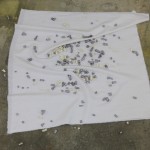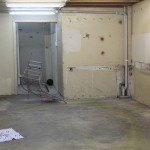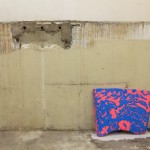Lilt
The idea behind the title Lilt, was to choose a word that had a kind of redundant or historical use, a word simple in form (a mild pleasure), yet seldom used. This was to draw attention to the arbitrary nature of the symbolic mode (semiotically) as an inverse to expected communication and meaning. In other words, this title, in a sense communicates nothing: it has no intrinsic meaning. However, the reader will be looking for meanings, generating connotations, that again are completely arbitrary. If a connotation was intended perhaps it is a kind of tilt, a double back on the word itself as a play on language, or more accurately a play on how we expect language to function; in this case a word that seems to mean something playful, but is merely a basic phonetic sound. There is a semi onomatopoetic dimension to this word that seems to imply its definition in its sound. This was what was appeared attractive: its material sound and its playful self-redundancy. There are no intended relationships to any of the work in the show, nor an attempt to ‘frame’ the show, and that is the point; the reader may write whatever meanings they chose to construct (which are of course from culture in the broadest sense). In this way the word has been written previously and is rewritten over and over; the signifiers keep multiplying. However, there is a relationship to the reuse of a material whether it be a word, a sound, a found object that links all the ‘elements’ of this show. The dislocated and ruptured nature of the text as unstable and mutable runs through all the work. It is important that with the change of one letter in a word creates a new word, thus ‘lilt’ could easily be ‘lift’ (as the spell check in Outlook wanted it to be), or ’tilt’ (which could be conceived as another play on a shift in the signifier). But these two words are too obvious and don’t allow the restless ambiguity and self-deceptive aspects of language to be released; for différance (Derrida) to come into play. In Lilt we find a deferral of meaning ; an overturning of the material signifier and production of the intertextual object.
Slug
There is a photograph titled Adobe (by Simon Horsburgh) depicting an indeterminate flat surface where a protrusion occurs: a lug in the same material. A photograph though without scale, proportion, identification; a detached referent, an indexical displacement. Adobe refers to a brick made of sun-dried clay, or perhaps an allusion to a process of digital manipulation; either way a Lacanian ‘point de capiton’, something to hold the stuffing of the subject in place; a recognisable signified—the context of the lug that is used to locate two parts is pertinent here (as in two parts of a mould). But the signifier slips, the caption, the title mobilises and the subject is no longer anchored—possibly pulled along by the hair (Lugga: Swedish, Lugge: Norwegian), dragged like a rap of cloth through the mud. The ear that is pulled; that lugge of refusal (Scottish, 1495) to adhere the caption to the image; the object to the referent.
This image, Adobe, had an immediate place in language; the idea of the lug etymologically and phonetically form an association with ‘slug’. The image generated this arbitrary signifier than in turn provided a turn on which a prior thinking around casting holes in walls of a space was released. In this scenario, the title is also completely arbitrary, and of no value to the writing of lug. Or slug. Lug in one sense means to pull something with effort, to move something heavy, while sluggard from middle-English is a lazy or idle person (Swedish: Slugga, a heavy, slow person), later being the noun for the slow moving snail like animal (1704).
The original conceptualisation of Slug was derived from another of its meanings as a piece of lead fired from a gun; to which the snail like animal is related in form. The textual association is with the holes in the walls of the space from plugs since removed, where the cavities remain; scars, traces of former uses. One of these uses being a Sports Power repair and storage facility, to which (so the story goes) a target of thick straw and cannite on the rear upstairs wall was used to fire shots for the sighting of rifles. Irrespective of accuracy (and validity of the story), another weave in the textual web was created. Along these chains of associative meaning, the word slug is also a boxing term, and a baseball term: both to hit hard, a hard blow. These definitions also refer to the impact of the bullet into a surface (a wall, flesh), while constructing an incongruous relation between the slow moving animal and the speed of a bullet.
Returning to the notion of the tissue of the text, and the linguistic body, the imaging of slugs being removed, excised, cut from flesh prompted the thinking of a representation of absence turned into positive. In other words, the negative spaces of the cavities made into moulds to which forms would be cast. The conception of a linguistic scare tissue as filling the void; the symbolic plugging the holes of the impossible encounter (the real), acting as ciphers of moments of jouissance; where the act of a projection occurs with cast objects (slugs) in lead and paper. The fragility of Tenguchu Japanese tissue paper and the heavy malleability of lead, both mutable and unstable, transformable; transpositions of text moving through a weave of permutations, associations and (material) potentialities.
Hence the conundrum for the reader as writer; where does the text begin or end? Where is the referent to which the reader may find ballast (a common use for lead), an affirmation of a subject? There is no beginning or end to this text, nor the texts discussed: akin to the meaning of slug as the piece of lead that was once used to space the lines of type in the letterpress, the slug of these words is apparent in its absence (leading: in typography) and presence as the object made from the negative of the mould (and the scars in the walls). The text formed these objects long before their material realisation, and the text continues to reshape and transpose them according to what is read and written. Only fleeting points de capiton for the text of signifiance.
- Slug, Brett Jones
- Lilt, Installation View
- Lilt, Installation view
- Lilt, Installation view
- Slug, Brett Jones
- Slug (detail), Brett Jones
- Broken, Brett Jones
- Broken, Brett Jones








